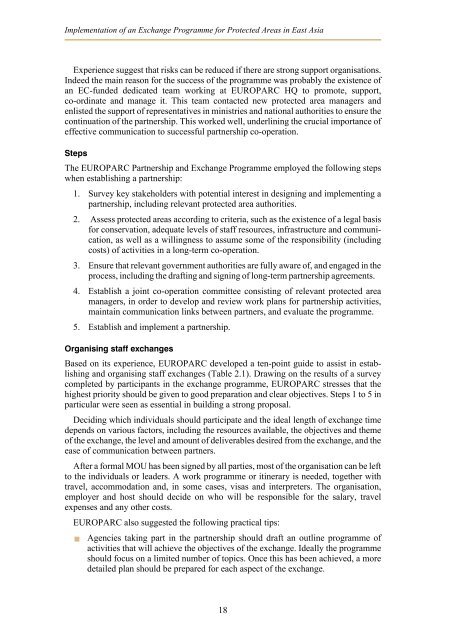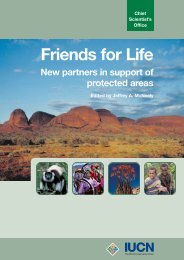Exchange programmes - IUCN
Exchange programmes - IUCN
Exchange programmes - IUCN
Create successful ePaper yourself
Turn your PDF publications into a flip-book with our unique Google optimized e-Paper software.
Implementation of an <strong>Exchange</strong> Programme for Protected Areas in East Asia<br />
Experience suggest that risks can be reduced if there are strong support organisations.<br />
Indeed the main reason for the success of the programme was probably the existence of<br />
an EC-funded dedicated team workingat EUROPARC HQ to promote, support,<br />
co-ordinate and manage it. This team contacted new protected area managers and<br />
enlisted the support of representatives in ministries and national authorities to ensure the<br />
continuation of the partnership. This worked well, underliningthe crucial importance of<br />
effective communication to successful partnership co-operation.<br />
Steps<br />
The EUROPARC Partnership and <strong>Exchange</strong> Programme employed the following steps<br />
when establishinga partnership:<br />
1. Survey key stakeholders with potential interest in designing and implementing a<br />
partnership, includingrelevant protected area authorities.<br />
2. Assess protected areas accordingto criteria, such as the existence of a legal basis<br />
for conservation, adequate levels of staff resources, infrastructure and communication,<br />
as well as a willingness to assume some of the responsibility (including<br />
costs) of activities in a long-term co-operation.<br />
3. Ensure that relevant government authorities are fully aware of, and engaged in the<br />
process, including the drafting and signing of long-term partnership agreements.<br />
4. Establish a joint co-operation committee consistingof relevant protected area<br />
managers, in order to develop and review work plans for partnership activities,<br />
maintain communication links between partners, and evaluate the programme.<br />
5. Establish and implement a partnership.<br />
Organising staff exchanges<br />
Based on its experience, EUROPARC developed a ten-point guide to assist in establishing<br />
and organising staff exchanges (Table 2.1). Drawing on the results of a survey<br />
completed by participants in the exchange programme, EUROPARC stresses that the<br />
highest priority should be given to good preparation and clear objectives. Steps 1 to 5 in<br />
particular were seen as essential in buildinga strongproposal.<br />
Deciding which individuals should participate and the ideal length of exchange time<br />
depends on various factors, includingthe resources available, the objectives and theme<br />
of the exchange, the level and amount of deliverables desired from the exchange, and the<br />
ease of communication between partners.<br />
After a formal MOU has been signed by all parties, most of the organisation can be left<br />
to the individuals or leaders. A work programme or itinerary is needed, together with<br />
travel, accommodation and, in some cases, visas and interpreters. The organisation,<br />
employer and host should decide on who will be responsible for the salary, travel<br />
expenses and any other costs.<br />
EUROPARC also suggested the following practical tips:<br />
� Agencies taking part in the partnership should draft an outline programme of<br />
activities that will achieve the objectives of the exchange. Ideally the programme<br />
should focus on a limited number of topics. Once this has been achieved, a more<br />
detailed plan should be prepared for each aspect of the exchange.<br />
18






